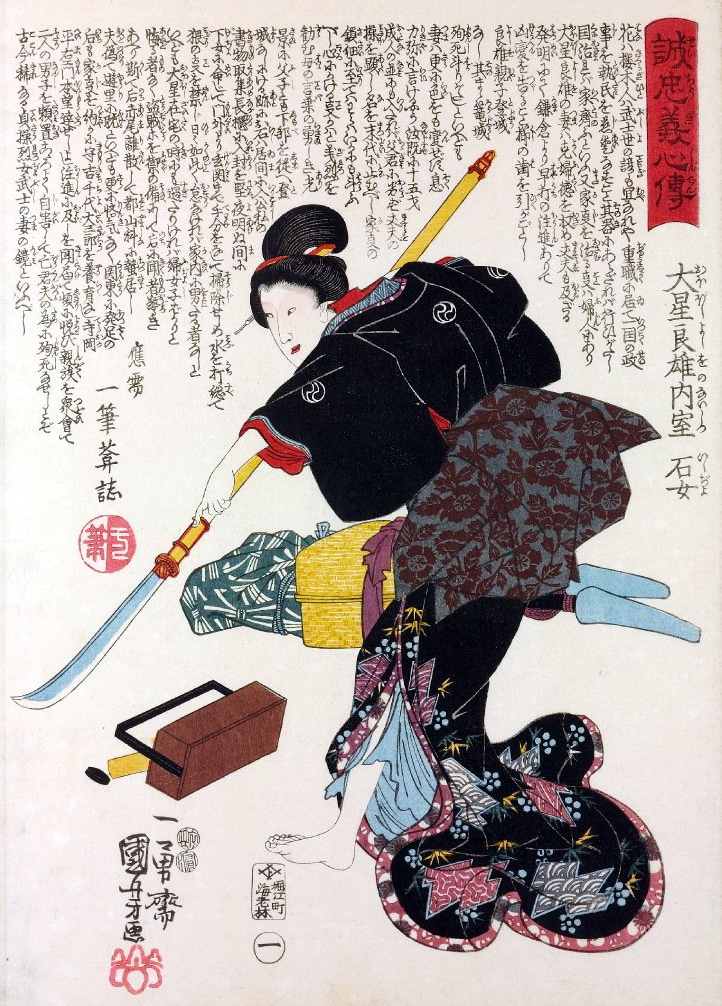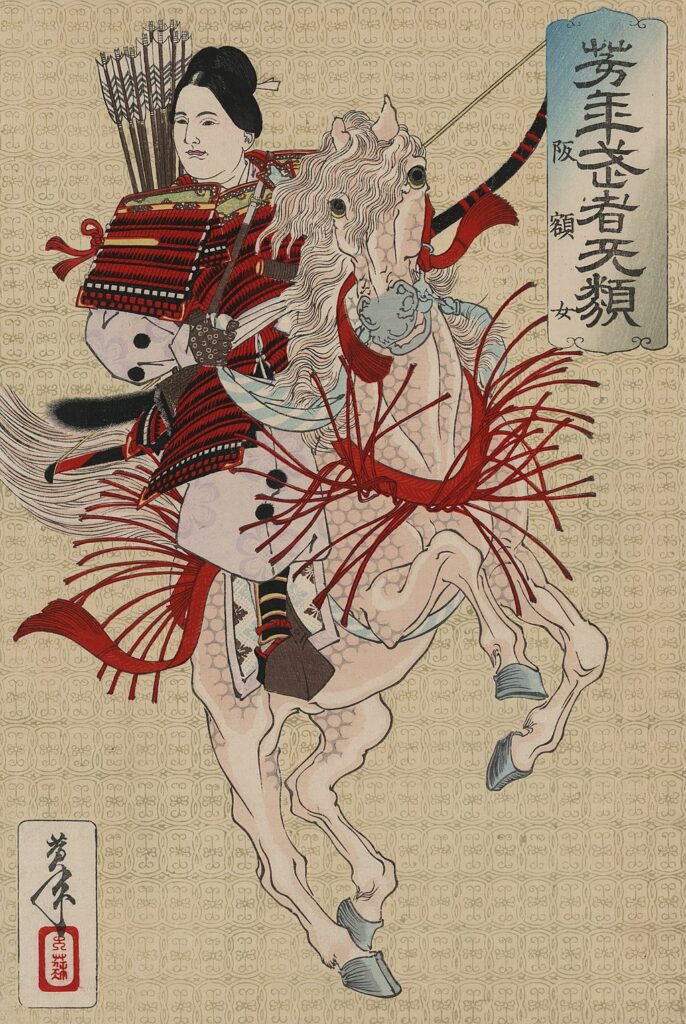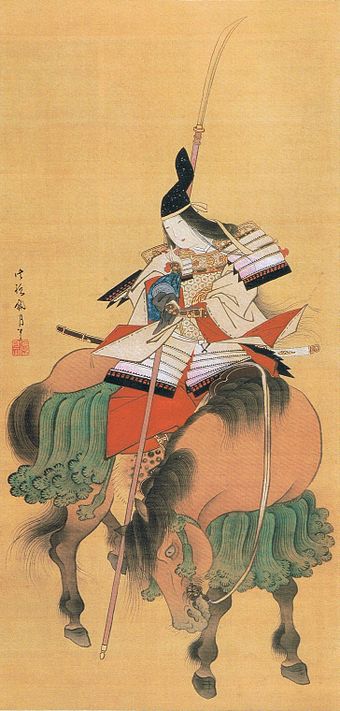The history of warfare is littered with great kings and armies of men of all ages and origins. Yet, regarding women, history leaves us with few examples.
The most famous – Joan of Arc, mythical Amazon warriors, or the Scythian female fighters – are far from being alone. The pages of history, if read carefully, are full of women fighting, defending, and dying for their homes and families.
Even the storied Japanese male samurai obscure their other fellow samurai. This is the history of Japan’s great female samurai warriors, the Onna-Bugeisha.

Who Were the Onna-Bugeisha?
The Onna-Bugeisha was a very real, very deadly class of fierce, skilled samurai warriors that existed for much of Japanese pre-modern feudal history.
Sometimes also known as Onna-musha, these women were highly-trained and fought alongside their male counterparts, samurai men, throughout times of war.
The term, Onna-Bugeisha, breaks down into onna, meaning ‘woman,’ and bugeisha, roughly meaning ‘warrior’ or ‘martial artist’ – a woman warrior.
As female samurai, it was their duty to protect their households, families, and sense of honor.
As members of the bushi or ‘warrior’ class, the Onna-Bugeisha were trained in the art of combat with many different weapons and, during battle, were every bit as brave and fearsome as their male peers.
The history of women warriors, also sometimes called Onna-musha, carries across many centuries, possibly millennia. The Kamakura, Sengoku, Edo periods and beyond are all filled with their heroism.
Figures like Empress Jingū, Tomoe Gozen, Hangaku Gozen, and the brilliant Aizu women were all incredible examples of legendary samurai women throughout the years.
Following the establishment of the Tokugawa shogunate and the dawn of the Meiji Restoration, the status of Japanese women in society underwent a significant transformation. This led to a complete shift in the position of Onna-Bugeisha and young women in general.
The modern era brought a decline in the influence of the samurai and limited women to domestic and traditionally feminine responsibilities. Consequently, the memory of Onna-Bugeisha started to wane.
Historical depictions of female warriors and their accomplishments disappeared from view. Yet, today, their stories are finally being told once again.
Empress Jingū
Easily the oldest and most powerful of all the Japanese woman warriors was the legendary Empress Jingū.
Her story traces all the way back to around 200 AD, the beginning of her reign after the death of her husband, Emperor Chūai.
Upon taking the throne for herself, the great Empress is said to have led an assault on Korea, despite being pregnant with her son, the future emperor, Ojin.
The stories tell of her riding into battle at the head of a great army and subduing the Korean peninsula. Many scholars debate whether or not her story is true or, instead, a fictional legend passed down through the ages.
If she did exist, she was undoubtedly a fearsome warrior and one of the greatest Onna-Bugeisha ever to live.
Hangaku Gozen
Another famous female samurai was the remarkable Hangaku Gozen. Member and ally of the Taira clan, Gozen can also be considered a female general – and quite a formidable one, at that.
In 1201, she was reported to have led a massive force, estimated around 3,000 men strong, during the Genpei War, as part of an event known as the Kennin Rebellion.
The Jo clan instigated the rebellion against the Kamakura shogunate under her uncle, Jo Nagamochi. Fighting alongside her uncle, Hangaku Gozen, and her forces proved to be instrumental to their 3-month long defense against the shogunate’s army.

Eventually, the rebels were overtaken. However, it was not until she was struck in the thigh by an arrow that Hangaku Gozen ceased fighting.
There have been many legendary samurai women throughout the ages – Yodo-dono, Niijima Yae, and the Ikko-ikki, among others – but few compare to the legendary figure of Tomoe Gozen.
Tomoe Gozen
Likely the most famous Onna-Bugeisha, Tomoe Gozen was essentially the archetype of the female samurai.
A general and prominent warrior for the Minamoto clan – enemies of the Hangaku Gozen’s Taira clan – she would lead men into fierce battle on multiple occasions during the Genpei War.
On one occasion, she would even command just 300 male samurai against a much larger force of 2,000 Taira warriors – and survive.

Exceptionally skilled in the art of combat with the sword, a remarkably strong archer, and outstanding at horseback riding, Tomoe Gozen was a fine warrior. Epic tales tell of her being a fearless rider, equal to thousands of male opponents, and unequaled in her mastery of the blade.
At the Battle of Awazu in 1184, Gozen defeated multiple foes before beheading the leader of the rival Musashi clan and offering his head to General Kiso Yoshinaka, her leader, throughout the fighting.
Her exceptional skills on the battlefield earned her great renown. Some say that Yoshinaka even regarded her as the first real general in Japan.
Today, scholars believe much of Tomoe Gozen’s history may be shrouded in legend. Still, nearly all agree that she was a real fighter.
And, most certainly, she must have been a force to reckon with.
The Weapons of the Onna-Bugeisha
As incredibly adept samurai fighters, the Onna-Bugeisha were likely skilled in many forms of combat and proficient with a wide array of weapons.
However, the weapon of choice was certainly the naginata.
The naginata is an adaptable, sword-like weapon consisting of a long shaft with a curved blade on the very end. Today, it’s considered a symbol of the warrior woman.
Onna-Bugeisha warriors were experts in combat with the naginata, but were also likely skilled in knife fighting and often wielded a Kaiken dagger at all times, always ready to fight and defend.
Edo Period and Changing Culture
During the Edo or Tokugawa period in Japan, the role and status of the Onna-Bugeisha underwent significant changes.
After the unification of Japan, Japanese women were encouraged to focus on managing the home and educating their children. Travel was highly restricted for even female warriors, who needed permits and were usually accompanied by men.
Overall, the onset of the 17th century brought a radical shift to the status of Japanese women in society. The dominant Neo-Confucian philosophy, along with other societal shifts, supposedly heralded a new order of peace, but the end result was closer to rigid social norms.
The Onna-Bugeisha, and their traditional roles and responsibilities, did not fit this new version of Japanese culture.
The earlier warrior culture gave way to a new code of conduct, bushido, that emphasized loyalty and honor, and martial arts training became, instead, a means for women to practice servitude towards the men of the household. Even the naginata was reduced to a symbol instead of a deadly weapon meant to be used.
However, some women still learned true fighting techniques, like Kenjutsu, and some broke tradition to become prominent swordswomen.
Throughout the Edo period, the role of the Onna-Bugeisha, the exceptional woman warrior, shifted from a focus on fighting and conflict to one of passive obedience as wives and mothers. The ideals of fearless devotion and selflessness were gradually replaced by quiet, compliant, civil obedience.
This would not be the end of Japan’s female samurai, however.
The Battle of Aizu & The Last Stand of the Onna-Bugeisha
As recently as the 1860s, during the Battle of Aizu in the Boshin War, Japan’s women warriors were still making their mark.
The battle saw the Aizu clan’s female samurai, including Nakano Takeko, fight to defend their home against 20,000 approaching soldiers of the Japanese empire.
The Aizu would train young women of the time to prioritize protecting their families, and many retreated to Tsuruga Castle to defend it against the enemy army. Though, around 20 to 30 women, led by Takeko, formed their own unit, the Jōshigun, to fight back against the invaders.
They disguised themselves as male samurai and wielded their naginata to fight the opposing imperial forces, armed with guns.
Many did not survive, but the samurai warriors’ bravely defended the castle for 30 days. Even so, the Aizu samurai, including their male counterparts, were eventually forced to surrender.
The Battle of Aizu is often viewed as one of the last stands of Japan’s special female warriors, marking the end of the samurai class.
Legacy of the Onna-Bugeisha
The legacy of the female samurai warriors of feudal Japan, the Onna-Bugeisha, is a complicated one.
A samurai class of highly-skilled, dangerous fighters, they fought tirelessly to guard their homes and protect their families. As such, they represent some of the greatest individuals in Japanese history.
The history of the Onna-Bugeisha is fascinating and awe-inspiring, yet it also raises questions about the roles women hold in society and the incredible figures that have been lost to history. What other forgotten stories of women warriors lie buried in history, waiting to be discovered and celebrated?
Changing times resulted in the fading historical memory of these impressive female samurai, but fortunately, their stories are being rediscovered and shared with the world once again.
Their tales can inspire and lead a new generation of women to be just as courageous and powerful as they were.
References
All That’s Interesting. “The Mysterious and Mythic Life of Japan’s Most Fearsome Female Samurai, Tomoe Gozen.” All That’s Interesting, All That’s Interesting, 13 July 2019, https://allthatsinteresting.com/tomoe-gozen.
Bohnke, Christin. “Onna-Bugeisha, the Female Samurai Warriors of Feudal Japan.” JSTOR Daily, JSTOR, 17 Dec. 2022, https://daily.jstor.org/onna-bugeisha-female-samurai-warriors-feudal-japan/.
“How Onna-Bugeisha, Feudal Japan’s Women Samurai, Were Erased from History.” VICE, Vice News, 24 Sept. 2018, https://www.vice.com/en/article/a383aj/female-samurai-onna-bugeisha-japan.
“Japan: Memoirs of a Secret Empire . Samurai Woman.” PBS, Public Broadcasting Service, https://www.pbs.org/empires/japan/tokaido_6.html.
Nowaki, Rochelle. “Women Warriors of Early Japan.” Hohonu, vol. 13, 2015, pp. 63–68.
Wright, D.E. “Female Combatants and Japan’s Meiji Restoration: The Case of Aizu.” War in history, vol. 8, no. 4, 2001, pp. 396–417., https://doi.org/10.1191/096834401680666445.

